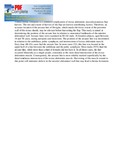| dc.description.abstract | Ventral hernia formation is a common complication of rectus abdominis musculocutaneous flap harvest. The site and extent of harvest of the flap are known contributing factors. Therefore, an accurate location of the arcuate line of Douglas, which marks the lower extent of the posterior wall of the rectus sheath, may be relevant before harvesting the flap. This study is aimed at determining the position of the arcuate line in relation to anatomical landmarks of the anterior abdominal wall. Arcuate lines were examined in 80 (44 male, 36 female) subjects, aged between 18 and 70 years, during autopsies and dissection. The position of the arcuate line was determined in relation to the umbilicus, pubic symphysis, and intersections of rectus abdominis muscle. Sixty four (80.4%) cases had the arcuate line. In most cases (52), this line was located in the upper half of a line between the umbilicus and the pubic symphysis. Most males (93%) had the arcuate line, while more than a third of females did not have it. In all these cases, the line occurred bilaterally as a single arcade, constantly at the most distal intersection of the rectus abdominis muscle. Consequently, the arcuate line is most reliably marked superficially by the distal tendinous intersection of the rectus abdominis muscle. Harvesting of the muscle cranial to this point will minimize defects in the anterior abdominal wall that may lead to hernia formation | en |

